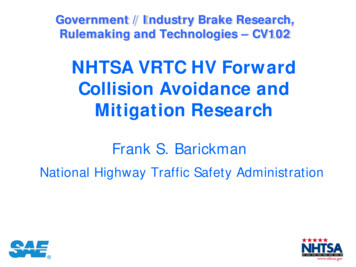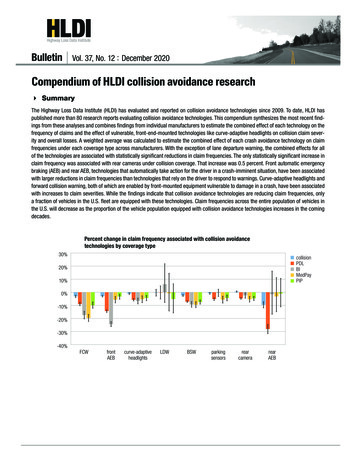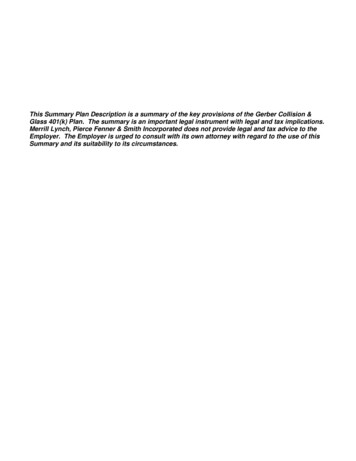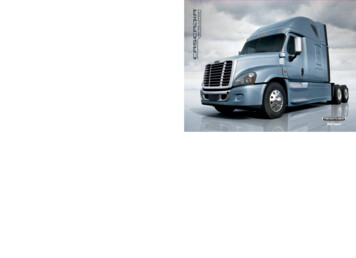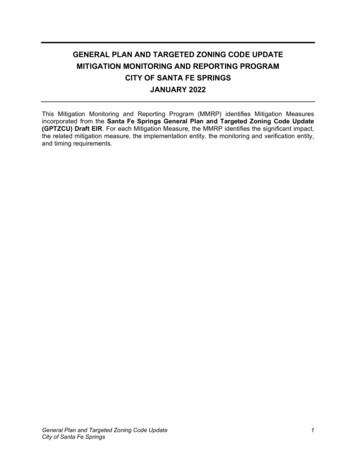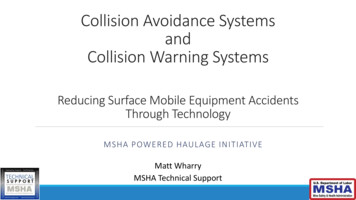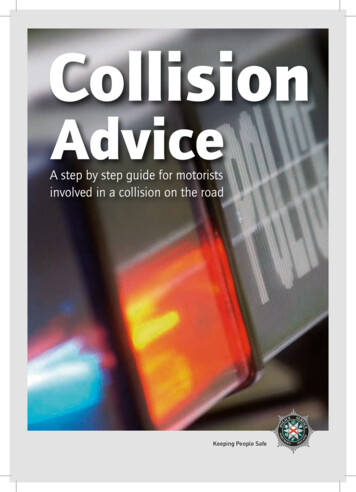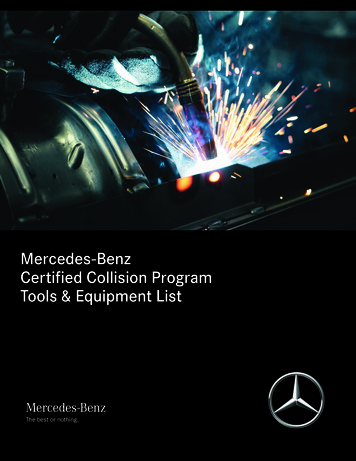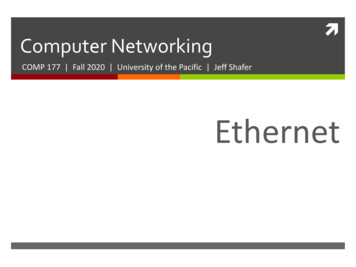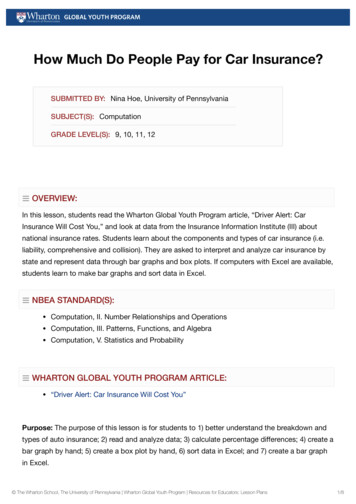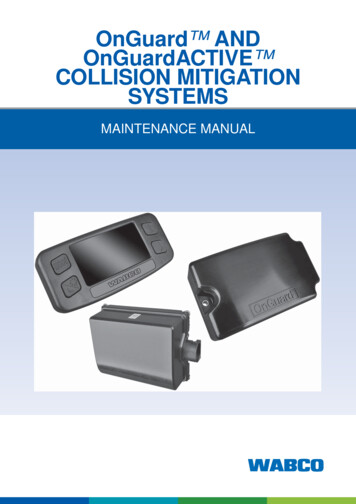
Transcription
OnGuard ANDOnGuardACTIVE COLLISION MITIGATIONSYSTEMSMAINTENANCE MANUAL
Service NotesAbout This Manual앫 OnGuardACTIVE Driver’s Tips, SP-1658This service manual applies to all vehicles equipped with theOnGuard and OnGuardACTIVE Collision Mitigation Systems.Visit Literature on Demand at meritor.com to access and orderadditional information.Before You BeginContact WABCO North America Customer Care at 855-228-3203.(United States and Canada); 001-800-889-1834 (Mexico); or emailwnacustomercare@wabco-auto.com.1.Read and understand all instructions and procedures beforeyou begin to service components.2.Read and observe all Warning and Caution hazard alertmessages in this publication. They provide information that canhelp prevent serious personal injury, damage to components,or both.3.Follow your company’s maintenance and service, installationand diagnostics guidelines.4.Use special tools when required to help avoid serious personalinjury and damage to components.If Tools and Supplies are Specified inThis ManualTOOLBOX Software (12.0 or higher) is available atwabco-auto.com.Hazard Alert Messages and TorqueSymbolsWARNINGA Warning alerts you to an instruction or procedure that youmust follow exactly to avoid serious personal injury anddamage to components.CAUTIONA Caution alerts you to an instruction or procedure that youmust follow exactly to avoid damage to components.@This symbol alerts you to tighten fasteners to a specified torquevalue.How to Obtain Additional Maintenance,Service and Product InformationFor Frequently Asked Questions (FAQs) and more information aboutOnGuard and OnGuardACTIVE , refer to the following:앫 FAQ publication, SP-14119앫 OnGuard Driver’s Tips, TP-1320Information contained in this publication was in effect at the time the publicationwas approved for printing and is subject to change without notice or liability.WABCO reserves the right to revise the information presented or to discontinue theproduction of parts described at any time.WABCO Maintenance Manual MM-1306 (Revised 08-18)
Driver InformationOnGuard Warnings, Cautions andOperating GuidelinesEnvironment-Related InformationDriver-Related InformationThe driver should consider the benefit/risk of using OnGuard Collision Mitigation System (CMS) under the followingconditions.WARNINGThe OnGuard Collision Mitigation System (CMS) is a driveraid only. It is designed to assist the vehicle operator inmaintaining a safe following distance and, if needed, providelimited initial braking to reduce the severity of a possiblecollision. It is not an auto-pilot system for operating thevehicle.The OnGuard CMS is no substitute for the most importantfactor in vehicle safety, which is a safe, conscientious driver.Use of OnGuard CMS cannot compensate for a driver that isdistracted, inattentive or impaired by fatigue, drugs or alcohol.As always, it is the driver’s responsibility to:앫 Use safe driving techniques앫 Exercise proper judgment for the traffic, road and weatherconditions앫 Maintain a safe distance between vehicles앫 Apply the brakes when needed to maintain control of thevehicleWhether OnGuard CMS is in use or not, the driver isresponsible for the vehicle’s speed, distance between othervehicles and braking the vehicle, if necessary, to avoid acollision. Never wait for an OnGuard CMS warning beforeapplying the brakes. Failure to do so can result in seriouspersonal injury or death, and/or severe property damage.WARNING앫 Weather such as rain, sleet, snow, ice, heavy fog, as well assmoke or dust. These conditions can make roads slipperywhich can cause a spinout, or block or limit the radar’sdistance sensing ability.앫 Construction zones, off road, dirt roads or muddy roadswith loose surface. These conditions can cause the wheelsto lose traction and limit OnGuard ’s ability to provideappropriate warning and adequate braking.앫 Curvy or winding roads, roads with sharp turns. Curvyroads can make it difficult for the OnGuard CMS radar totrack vehicles in it’s path. While in a sharp turn or if thepreceding vehicle is in a sharp turn, OnGuard may nolonger track a vehicle in front of you. Your vehicle couldthen unexpectedly accelerate to the previously selectedspeed.앫 Heavy or complicated traffic, entry and exit ramps,downhill, cross traffic and intersections. OnGuard CMS isnot capable of taking into account these complex trafficsituations and respond to each scenario. It cannot tracktraffic and objects traveling perpendicular to it’s path.Driving in these conditions with OnGuard CMS active canproduce false warnings, unexpected braking or no response atall. Serious personal injury or death, and/or severe propertydamage can result.WARNINGWARNINGThe driver is responsible for understanding the operation andlimitations of the OnGuard CMS before operating thevehicle. Failure to do so can result in serious personal injury ordeath, and/or severe property damage.The OnGuard Collision Mitigation System (CMS) is designedto monitor only the distance between your vehicle and thevehicle moving in the same direction directly ahead of it. Itmay not identify a vehicle moving TOWARDS it or stationaryobjects in the road, such as a vehicle that is stopped in trafficor disabled. As such, the OnGuard System will not provideengine torque control or braking. The driver must always beaware of the objects in front of his vehicle and be ready toapply the brakes, if required. Failure to apply the brakes whenneeded can result in an accident.WABCO Maintenance Manual MM-1306 (Revised 08-18)i
Driver InformationOnGuard CMS is designed to detect and track common sizeautomobiles and trucks with metal surfaces. It is not designedto detect smaller objects such as pedestrians, narrowvehicles, motorcycles, mopeds, bicycles, or similar sizeditems. It also cannot detect vehicles of unusual shape or withlimited metal surfaces, such as recreational vehicles,horse-drawn buggies, or logging trailers. The OnGuard system may provide little or no warning of these objects in thevehicle’s path. It is the driver’s responsibility to be aware ofthese objects and apply the brakes as necessary to avoid anaccident.It is always the driver’s responsibility to apply the brakes, ifneeded, to avoid an accident. Never wait for an OnGuard CMS warning before applying the brakes. Failure to apply thebrakes when needed can result in serious personal injury, ordeath, and/or severe property damage.System-Function InformationWARNINGOnce the driver applies the brake, the OnGuard CMS will bedisabled and no longer provide braking intervention. It is thedriver’s responsibility to maintain a safe speed and distancefrom other vehicles and brake as necessary to maintainvehicle control. Failure to apply the brakes when necessarycan result in serious personal injury or death, and/or severeproperty damage.WARNINGThe driver is responsible for selecting a safe and legal speedsetting that is appropriate for the traffic, road surface andweather conditions. Adjust the speed setting as necessarywhen driving in reduced visibility or potentially slickconditions. Driving with the OnGuard CMS at a speed that isinappropriate for following a vehicle safely can lead to anaccident. Serious personal injury or death, and/or severeproperty damage can result.WARNINGWhile the OnGuard CMS is in System/Radar Alignmentmode, the system will not track vehicles or operate. Make surethat the Service Alignment procedure is completed beforereleasing the vehicle from service. Failure to do so can resultin serious personal injury or death, and/or severe propertydamage.iiWABCO Maintenance Manual MM-1306 (Revised 08-18)WARNINGIf a potential collision is developing and the driver does nottake action to decelerate the vehicle, the OnGuard CMSsounds an alert, automatically de-throttles the engine, andsends a message to the ABS ECU requesting foundation brakeapplication to provide up to 0.35g of braking power. (Forinformation about the ABS system, refer to the latest ABSmaintenance manual available from Literature On Demand atwww.wabco-auto.com.) The driver must still apply the brakesto provide additional braking force to help avoid an accident.Failure to apply the brakes when necessary can result inserious personal injury or death, and/or severe propertydamage.WARNINGDo not allow the installation of bumpers, cattle guards or othersuch items in front of the radar area. If the radar is blocked,the OnGuard CMS will have limited or no functionality, whichcan lead to an accident. Serious personal injury or death, and/or severe property damage can result.WARNINGOnGuard CMS automatically becomes active once thevehicle reaches a speed of 15 mph (24 kph). It does notprovide warning and braking functionality below 15 mph (24kph). It is the driver’s responsibility, at all times, to use safedriving techniques, be alert, maintain a proper distancebetween vehicles and brake the vehicle, if needed, to avoid acollision. Never wait for OnGuard CMS to provide a warningor braking before applying the brakes. Failure to do so canresult in serious personal injury or death, and/or severeproperty damage.WARNINGOnGuard CMS may initiate forward collision warnings or inseldom cases unwanted or inappropriate acceleration ordeceleration. In such cases, the driver has to either deactivateor override the system as necessary to maintain proper vehiclecontrol. Failure to do so can result in serious personal injury ordeath, and/or severe property damage.
Driver InformationWARNINGIf the driver accelerates to a faster speed than the one set toovertake a vehicle, OnGuard CMS will return to the laststored speed once the driver removes his/her foot from theaccelerator pedal. The driver must be aware of the last storedspeed to make sure that the vehicle can remain in control ordeactivate the system. Failure to do so can result in seriouspersonal injury or death, and/or severe property damage.WARNINGOnGuard CMS may take a few moments to adjust to theselected speed. Adjust the speed as necessary toaccommodate the current road, traffic and weather conditions.Use care to avoid dramatic acceleration or deceleration of thevehicle which can lead to a loss of control. Serious personalinjury or death, and/or severe property damage can result.WARNINGUsing the “Resume” option will return the vehicle to the laststored set speed. It is the driver’s responsibility to be aware ofwhat the last stored speed is and ensure it is safe and legal forthe current road, traffic and weather conditions. Failure to doso can result in serious personal injury or death, and/or severeproperty damage.System Functions and MiscellaneousInformationWARNINGAlways keep the path of the radar clear of obstructions. Snowyand muddy conditions can cause the radar to become blockedor debris to get between the fascia and radar. Always removesnow, mud or other debris from the front of the fascia andbetween the fascia and radar immediately to ensure properradar operation. Do not allow the installation of bumpers,shields, deflectors, guards or other such items in front of theradar area. Do not allow items to block the radar or theOnGuard CMS will have limited or no functionality, whichcan lead to an accident. Serious personal injury or death, and/or severe property damage can result.WARNINGThe OnGuard CMS requires time to recognize an object orpotential obstacle. An object moving at a speed ofapproximately 20 mph or more may not be recognized inenough time to produce a warning or brake the vehicle. Neverwait for the OnGuard CMS to intervene when a potentiallyhazardous situation arises. The driver must always monitortraffic and apply the brakes, if needed, to avoid a crash.Failure to do so can result in serious personal injury or death,and/or severe property damage.System Malfunction InformationWARNINGDo not allow the fascia to become blocked by any foreignmatter (dirt, snow, ice, stickers etc.), otherwise a system faultwill occur and the OnGuard CMS will be disabled. If thesystem becomes disabled, immediately inspect theOnGuard CMS fascia for a blockage and correct it asnecessary. Whether or not the radar is working correctly, it isthe driver’s responsibility to apply the brakes when necessaryto maintain vehicle control. Failure to do so can result inserious personal injury or death, and/or severe propertydamage.WARNINGIf the OnGuard CMS is not correctly tracking vehicles thatare in your lane or is tracking vehicles that are not in your lane,this may be due to radar operational issues. Typically, theseare radar operational issues that can result from the followingproblems:앫 Debris (dirt, snow, ice) on the radar fascia or between thefascia and the radar sensor. This must be removed.앫 A loose radar sensor or one that is not tightly secured onthe mounting bracket.앫 The radar sensor may be too close to or actually contactingthe bumper as mounted. There should be at least 1/4 inchof clearance between the fascia, radar sensor or bracketand the bumper.앫 Radar interference from other radar sources or strong radarreflections.WABCO Maintenance Manual MM-1306 (Revised 08-18)iii
Driver InformationIf OnGuard CMS is not functioning correctly or as expected,immediately have the OnGuard CMS inspected to correct theissue. Whether or not the radar is working correctly, it is thedriver’s responsibility to apply the brakes when necessary tomaintain vehicle control. Failure to do so can result in seriouspersonal injury or death, and/or severe property damage.WARNINGWhen active Diagnostic Trouble Codes (DTCs) are present, theOnGuard CMS may be partially or fully disabled dependingon whether the DTC(s) is associated with the Adaptive CruiseControl (ACC) functions or the CMS functions. If OnGuard CMS is not functioning correctly or as expected, have theOnGuard CMS inspected immediately to correct the issue.Whether or not the radar is working correctly, it is the driver’sresponsibility to apply the brakes when necessary to maintainvehicle control. Failure to do so can result in serious personalinjury or death, and/or severe property damage.WARNINGIf the OnGuard CMS is not correctly tracking vehicles thatare in your lane or is tracking vehicles that are not in your lane,the radar may not be aligned correctly. If this occurs,immediately have the OnGuard CMS radar inspected andcorrected as needed. Refer to the Radar Sensor ServiceAlignment procedure. Whether or not the radar is workingcorrectly, it is the driver’s responsibility to be aware of vehiclesin front of the driver’s vehicle and apply the brakes whennecessary to maintain vehicle control. Failure to do so canresult in serious personal injury or death, and/or severeproperty damage.WARNINGIf OnGuard CMS is not providing alerts as expected,immediately have the OnGuard CMS inspected to correct theissue. Whether or not the radar is working correctly, it is thedriver’s responsibility to apply the brakes when necessary tomaintain vehicle control. Failure to do so can result in seriouspersonal injury or death, and/or severe property damage.ivWABCO Maintenance Manual MM-1306 (Revised 08-18)WARNINGIn order to reduce the potential danger of injuries causedduring OnGuard activated vehicle decelerations, the driverand front passenger must always be correctly seated and withseat belts correctly fastened when operating the vehicle.Additionally, the driver should secure all loose items in the cabso that they will not fly forward during a full brake application.
Contentspg. 1235Section 1: IntroductionOverviewOnGuard and OnGuardACTIVE How OnGuard and OnGuardACTIVE WorkIn-Cab Dash DisplayOperating ModesSystem LimitationsSystem ComponentsSection 2: Diagnostics, Troubleshooting andTesting262728General InformationRadar Sensor and Display Software LevelsError Screens and Diagnostic Trouble CodesRequired MaintenanceTroubleshooting GuideTOOLBOX SoftwareOnGuard and OnGuardACTIVE Radar DiagnosticTrouble Code TableRadar Inspection and Preventive MaintenanceRadar System TroubleshootingElectrical System TroubleshootingComponent Message Fault TroubleshootingCruise Control System Troubleshooting29Section 3: Component Replacement6101223Radar SensorDisplay Replacement
1 IntroductionOverview1 IntroductionOnGuard and OnGuardACTIVE OnGuard and OnGuardACTIVE are Collision Mitigation Systems(CMS) that offer Following Distance Alert (FDA) and Adaptive CruiseControl (ACC) with active braking, if equipped. These systems arecurrently available for pneumatically braked vehicles.How OnGuard andOnGuardACTIVE WorkThe OnGuard and OnGuardACTIVE systems detect objectsahead and measures the vehicle’s position and speed in relation toothers on the road to warn the driver of a possible rear-end collisionby providing audible, visual and haptic warnings. When appropriate,the system will apply the brakes to help mitigate a rear-end collision.The system monitors the road and provides warnings and activebraking even when cruise control is not set. The system also warnson stationary objects, such as cars, to alert the driver of potentialobstructions in their lane.The CMS is not intended to replace driver control of the vehicle atany time. You, as the driver, remain in control of your vehicle andultimately determine the actions that are necessary for safeoperation.The active braking application is intended to assist the driver toavoid or reduce the severity of a collision. The driver must take theappropriate corrective action in response to the collision warning.OnGuard and OnGuardACTIVE CMS warnings will not beissued below a vehicle speed of 15 mph.FDAFDA will generate an audible and visible alert when the vehicle’sfollowing distance may result in a collision. FDA provides only awarning and will not control vehicle speed unless ACC is engaged ora collision mitigation event is detected. FDA cannot be turned offand is always active at speeds above 15 mph on OnGuard systems, and from 15-17 mph on OnGuardACTIVE systems.ACC (If Equipped)ACC adjusts the speed of your vehicle while in cruise control andattempts to maintain a set following interval defaulted at 3.6seconds when there is a vehicle ahead driving at a lower speed thanyour vehicle.ACC works in conjunction with conventional cruise control tomaintain the set cruise speed when the lane ahead is clear and willautomatically adjust the vehicle’s speed to maintain the set followinginterval when a vehicle ahead is detected. The CMS achieves the setfollowing interval by controlling engine torque, engine andfoundation brakes without driver intervention.CMSThe OnGuard and OnGuardACTIVE CMS assists the driver inrecognizing and responding to potentially dangerous drivingscenarios that could lead to a rear end collision. The systemresponds by sending warnings, automatically reducing enginetorque and applying foundation brakes.The CMS will provide both visual and audible alerts through anin-cab dash display when the vehicle’s following interval could resultin a rear-end collision. If a potential rear-end collision is developingand the driver does not take action to decelerate the vehicle, theCMS’s active braking feature issues a haptic warning (short brakepulse) and automatically de-throttles the engine.If a potential rear-end collision still exists, and the driver has nottaken the appropriate action, the CMS will request application of thefoundation brakes to provide up to 50% of available braking power.When the CMS requests application of the vehicle’s brakes, thebrake lights will come on.NOTE: Cruise control is the standard OEM system that maintains avehicle speed set by the driver. If your vehicle does not have cruisecontrol, ACC functionality does not apply.In-Cab Dash DisplayThe in-cab dash display has five different screen background colors.Blue: General operating mode with no target vehicle detectedGreen: Target vehicle detected aheadYellow: Following distance alert, System capability warningRed: Collision warning, Stationary object warningAmber: Diagnostic Trouble Code (DTC) screenWABCO Maintenance Manual MM-1306 (Revised 08-18)1
1 IntroductionOperating ModesFollowing Distance Alert: Adaptive Cruise ControlNot SetAdaptive Cruise Control Not SetThe vehicle operates as usual when the ACC speed is not set. Thesystem will still emit audible and visual warnings when it detects apossible rear-end collision. The OnGuard CMS is active above 15mph and will request brake application if deemed necessary. TheOnGuardACTIVE CMS is active from 15-77 mph and will requestbrake application if deemed necessary.Once the vehicle is traveling faster than 15 mph, the followingscreens will be displayed. Figure 1.1.The Following-Distance Alert will provide an audible alert and thein-cab dash display screen will turn yellow if the vehicle is followinganother vehicle too closely at a 1.5 seconds following interval(tailgating). This alert will end when the following distance isincreased to a safe level or if the speed drops below the lead vehiclespeed. Figure 1.3.Figure 1.3Figure 1.1Cruise Control not set.Following distance alert.Cruise Control not set.No lead vehicle detected.4011857aCruise Control not set.Lead vehicle detected.Figure 1.34011856aFollowing Distance Alert: Adaptive Cruise ControlSetFigure 1.1Adaptive Cruise Control SetWhen the ACC speed is set, the set cruise speed appears on thedisplay. When a slower vehicle is detected in front of the vehicle,ACC will attempt to reduce the speed to the speed of the leadvehicle. This speed adjustment may momentarily drop lower thanthe lead vehicle in order to maintain a 3.6 seconds following intervalbetween the vehicle and the vehicle ahead when appropriate. WhileACC is on, the display will emit visual and audible collision warnings,and the system will control throttle and apply engine and servicebrakes if needed while attempting to maintain a set followinginterval. Figure 1.2.When the vehicle is in cruise control mode, the Following-DistanceAlert will provide an audible alert and the in-cab dash display screenwill turn yellow if the driver uses the accelerator pedal to overridethe ACC and approaches a vehicle too closely. The OnGuard Following-Distance Alert will not provide warnings when the vehiclespeed is below 15 mph. The OnGuardACTIVE Following-DistanceAlert will not provide warnings when the vehicle speed is below 15mph or over 77 mph. Figure 1.4.Figure 1.4Figure 1.2Cruise Control set. Following distance alert.ACC at maximum braking and requestingadditional driver braking.4011859aCruise Control set.Cruise Control set.No lead vehicle detected. Lead vehicle detected.4011858aFigure 1.22WABCO Maintenance Manual MM-1306 (Revised 08-18)Figure 1.4
1 IntroductionCollision Warning and MitigationWhen an unforeseen event occurs, such as another vehicle entersthe vehicle’s lane traveling slower than the vehicle, or the gapbetween the vehicles becomes too close, the CMS will provide anaudible alert and the display will turn red with a collision warningsymbol. If the system determines that a rear-end collision isimminent, it will automatically apply the brakes to reduce thevehicle’s speed. The driver may also feel a haptic warning (shortbrake pulse) to warn of collision danger. The driver must also takethe appropriate corrective action to avoid dangerous drivingsituations. Figure 1.5.The OnGuard CMS will not be active when the vehicle’s speed isbelow 15 mph. If the OnGuard CMS detects a stationary object inthe vehicle’s lane (such as a disabled car) it will provide an audiblealert and the display will turn red showing a stationary objectsymbol. The OnGuard CMS will not apply the brakes orreduce the vehicle’s speed when it detects a stationary object.The OnGuardACTIVE CMS will not be active when the vehicle’sspeed is below 15 mph or over 77 mph. If the OnGuardACTIVE CMS detects a stationary object (such as a disabled car) it willprovide an audible alert, followed by a haptic warning and then abrake application to reduce the vehicle’s speed.Figure 1.5앫 Should not be relied on to track lead vehicles when travelingthrough a severe curve in the road. Because of this, ACC is notrecommended for use on winding (curving) roads.앫 Should not be relied upon to track smaller objects (e.g.motorcycles, mopeds, bicycles, pedestrians, etc.).앫 Should not be relied on to alert drivers to vehicles in an adjacentlane.앫 Will alert but not actively brake on stationary objects.System ComponentsRadar SensorThe radar sensor is used to detect vehicles and obstacles for theOnGuard Collision Mitigation System. It is mounted in the front ofthe vehicle near the center of the bumper and recessed in thebumper in most applications. Figure 1.6. The sensor has anelectrical connector that provides power, ground andcommunication to the SAE J1939 network which is required forcorrect operation.The mounting orientation is determined by the 3 hole bolt pattern ofthe bracket. The radar sensor generally is mounted with theconnector on the driver’s side of the vehicle. The sensor connectoris protected by a rubber boot. This boot should fully cover theconnector upon completion of the sensor installation or repair.Figure 1.6ObjectCollision WarningStationaryCollision Warning4011860aFigure 1.5System LimitationsOnGuard and OnGuardACTIVE CMS only brake for movingobjects located directly in front of your vehicle. The OnGuard CMS does not operate when your speed is below 15 mph. TheOnGuardACTIVE CMS does not operate when your speed is below15 mph or over 77 mph. Accordingly, the CMS:앫 Will not react and alert the driver to objects crossing in front ofthe vehicle or oncoming traffic.4010334aFigure 1.6FasciaThe fascia is a protective cover for the radar sensor and isassembled to the same bracket on which the radar sensor ismounted. Some vehicle manufacturer’s use other fascia designs.Only original equipment fascias supplied by WABCO and the vehiclemanufacturer may be used to protect the radar sensor. Figure 1.7.WABCO Maintenance Manual MM-1306 (Revised 08-18)3
1 IntroductionThe fascia should not be blocked by any foreign matter (dirt, snow,ice, stickers, etc.), otherwise a system fault will occur and theOnGuard system will be disabled.Figure 1.74010335aFigure 1.7DisplayThe OnGuard display provides the interface for the driver.Figure 1.8. Audible and visual warnings, as well as verification ofcorrect system operation and faults, are communicated to thedriver. The driver is able to monitor the status of lead vehicles thatthe OnGuard system is tracking. The functions of the OnGuard display may be integrated into a vehicle’s instrument panel. If thevehicle has an integrated display, please refer to your vehicleowner’s manual for correct operation.Figure 1.84010554aFigure 1.84WABCO Maintenance Manual MM-1306 (Revised 08-18)SAE J1939 NetworkThe SAE J1939 Serial Control and Communications Heavy-DutyVehicle Network allows various electronic controllers on the vehicleto interact efficiently and in coordination with each other. Theinteractions between controllers include sharing sensor data,calculated information, subsystem operating state andconfiguration. This communication allows subsystems to influenceeach other’s operation.
2 Diagnostics, Troubleshooting and TestingGeneral Information2 Diagnostics, Troubleshooting and TestingRadar Sensor and Display Software LevelsMany diagnostic and troubleshooting procedures will requireknowledge of the software version of the radar sensor and display.Multiple DTCs may be active simultaneously. If a DTC is shown onthe display, use the UP and DOWN keys on the display to scrollthrough each code. Figure 2.2. Record each DTC for futurereference.Figure 2.2DISPLAY UP/DOWN KEYSNOTE: The radar sensor software version is determined usingTOOLBOX Software.The display software revision level is determined using the followingdisplay operating procedure.1.Turn the ignition key ON and wait for the display to power up.2.Press the “Mode” key on the display several times until thescreen labeled “Software Rev” shown in Figure 2.1 appears.4010554bFigure 2.1Figure 2.2SOFTWARE REVDisplaySOF0862XX4010389aFigure 2.1NOTE: Take note of the software version of each component forreference during maintenance procedures and repairs.Error Screens and Diagnostic Trouble CodesIf the system is not operating correctly, an error screen or a screencontaining Diagnostic Trouble Codes (DTCs) may be shown on thedisplay. Only currently active DTCs are displayed.NOTE: It is important to document any DTC that is displayedbecause stored DTCs are not displayed and are only retrievable withTOOLBOX Software.NOTE: When active DTCs are present, the system may be partiallyor fully disabled depending on whether the DTC(s) is associated withthe ACC functions or the CMS functions.CMS DTCs may become active during service procedures on otherelectrical system components (e.g., engine, transmission, ABS,etc.). If there are other vehicle systems with faults, they should berepaired first. After completion of service on the other vehiclesystem components, cycle the ignition OFF for at least two minutesand then turn the ignition back ON. Start the engine and run it at idlespeed for at least two minutes. This frequently clears the CMSDTCs.Required MaintenanceA service alignment is required after completion of any adjustments,repairs, replacement or maintenance affecting tires, chassis, orfront body components. For information about service alignment,refer to the Radar Sensor Service Alignment Procedure in thissection.NOTE: Failure to complete the required service alignment mayresult in driveability concerns. The system performance may beaffected.The following, although not all-inclusive, is a list of service,maintenance, and repair operations requiring CMS servicealignment:앫 Chassis parts replacement앫 Steering or suspension parts replacement, adjustment, oralignment앫 Tire inflation or size change, and/or tire replacement앫 Front body parts replacement or adjustmentWABCO Maintenance Manual MM-
wabco-auto.com. Driver Information WABCO Maintenance Manual MM-1306 (Revised 08-18) i OnGuard Warnings, Cautions and Operating Guidelines Driver-Related Information . inappropriate for following a vehicle safely can lead to an accident. Serious personal injury or death, and/or severe property damage can result. WARNING
